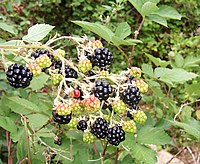
Photo from wikipedia
The antioxidant activity, and total phenolic, flavonoid, anthocyanin and carotenoid contents were evaluated for five fruits native to the Atlantic Rainforest. For fully ripen fruits, total flavonoid content was significantly… Click to show full abstract
The antioxidant activity, and total phenolic, flavonoid, anthocyanin and carotenoid contents were evaluated for five fruits native to the Atlantic Rainforest. For fully ripen fruits, total flavonoid content was significantly higher (p = 0.05) for fruits of butia (12.3 mg/100 g) and uvaia (11.2 mg/100 g) (Table 2). Fruits of lemon guava and gabiroba presented total phenolic contents (over 4,300 mg GAE/100 g) significantly higher (p = 0.05) than the other fruits used in this study. Total anthocyanin content (TAC) for fully ripen strawberry guava (216 mg/100 g) was significantly higher (p = 0.05) than the TAC found for any of the other fruits used in this study (Table 2). Total carotenoid content (176 mg/100 g) was significantly higher (p = 0.05) in fruits of butia. The antioxidant activity of gabiroba fruits (26.45 mM TROLOX equivalents/g DM, DPPH) was significantly higher (p = 0.05) among the fruits used in this study. Reduction in total phenolic and flavonoid contents was found for gabiroba, strawberry guava and uvaia fruits following ripening, except for butia (Table 2). Progressive reduction in antioxidant activity paralleled reductions in total phenolic and flavonoid contents. A remarkable increase in total anthocyanins from 18 to 216 mg/100 g was found for strawberry guava fruits during ripening. Data from this study demonstrate that various virtually unknown fruits native to the Atlantic Rainforest, especially gabiroba, present very high antioxidant activity and very high amounts of compounds known to promote human health.
Journal Title: European Food Research and Technology
Year Published: 2018
Link to full text (if available)
Share on Social Media: Sign Up to like & get
recommendations!